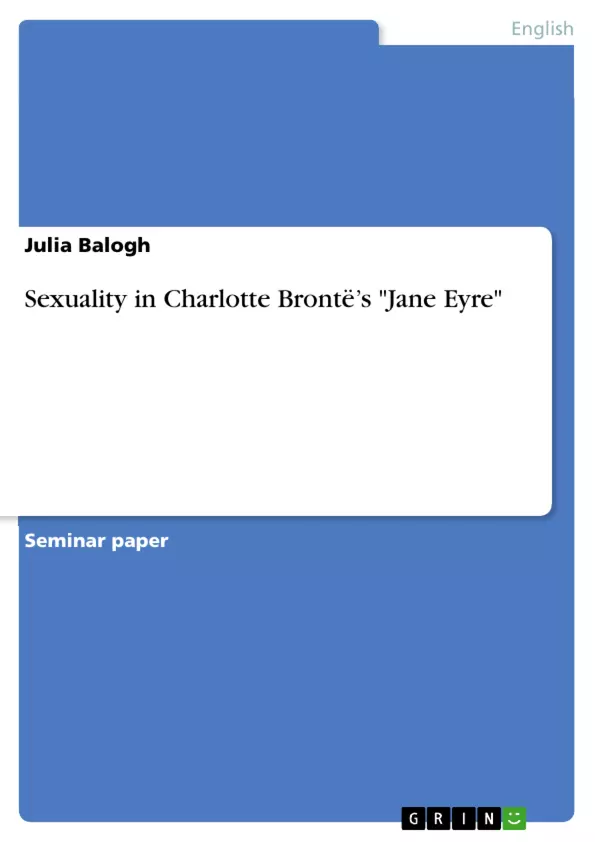Wherever you let your eye travel these days you come across sexuality and nakedness. Three beautiful women are nakedly smiling at you from a huge advertising poster for a solarium, in the advert break on TV a woman tears an attractive man’s clothes because she is mesmerized by his new scent, and in the phone book you can even find a voucher which guarantees you a bottle of champagne for free if you book a one hour-service in a certain brothel . Sexuality, and along with it desire and lust are accepted that much that they indeed build the base for a huge manufacturing branch.
Of course, this has not always been the case. Sensuality and passion have been fought and punished in earlier times. During the Victorian era for example they have even been seen as dangerous and attacking the mental as well as the physical health. When in 1847 Charlotte Brontë’s successful novel Jane Eyre was published, it caused riot and rage because of how the topic “sexuality” was dealt with.
In this paper I am going to explain the Victorian beliefs and notions regarding this topic. Furthermore I am going to reveal the attitude of the characters Jane Eyre, Edward Rochester and Bertha Mason towards sexuality. Before though, I will give a short biography of Charlotte Brontë, to depict how her own attitude differed from the social conventions and expectations of her time.
Inhaltsverzeichnis (Table of Contents)
- Introduction
- Sexuality in Charlotte Brontë's Jane Eyre
- Charlotte Brontë - A Short Biography
- Bertha Mason – “The Madwoman In The Attic”
- Jane Eyre - \"A Heterogeneous Thing”
- Edward Rochester – “A Spiritual Transformation”
- Conclusion
- Sources
Zielsetzung und Themenschwerpunkte (Objectives and Key Themes)
This paper aims to explore the Victorian era's perception of sexuality and its depiction in Charlotte Brontë's novel, Jane Eyre. The paper will examine how the characters of Jane Eyre, Edward Rochester, and Bertha Mason navigate and challenge these societal norms. It will also provide a brief biography of Charlotte Brontë, shedding light on her own stance on sexuality and its implications for her writing.
- Victorian attitudes towards sexuality and their consequences for women
- The portrayal of female desire in the context of societal expectations
- The dynamics of power and control in relationships between men and women
- The representation of madness and its connection to female sexuality
- The exploration of social class and its impact on individual freedom and expression
Zusammenfassung der Kapitel (Chapter Summaries)
- Introduction: This chapter contextualizes the discussion of sexuality in Victorian England, highlighting the stark contrast between contemporary attitudes towards sexuality and those prevalent during the Victorian era. It introduces Jane Eyre as a controversial work that challenged these norms, sparking societal debate.
- Sexuality in Charlotte Brontë's Jane Eyre: This chapter provides a brief biography of Charlotte Brontë, examining her personal experiences and their influence on her writing. It delves into the portrayal of Bertha Mason, Edward Rochester's wife, as a symbol of uncontrolled female desire and its consequences within a patriarchal society.
- Charlotte Brontë - A Short Biography: This section delves into the life of Charlotte Brontë, highlighting her experiences in a society where women's aspirations were often restricted. It discusses her unconventional behavior in the context of the Victorian era, particularly her pursuit of education and her refusal of marriage proposals.
- Bertha Mason – “The Madwoman In The Attic”: This chapter analyzes the character of Bertha Mason, who represents repressed female desire in Victorian society. It examines the ways in which her alleged insanity is linked to her sexuality and her rejection of social norms. Her tragic fate serves as a warning to women who dare to defy conventional expectations.
- Jane Eyre - “A Heterogeneous Thing”: This section focuses on the character of Jane Eyre, presenting her as a complex and independent woman navigating the constraints of Victorian society. Her journey explores themes of self-discovery, resilience, and the search for equality and autonomy. It highlights her resistance against societal expectations for women.
- Edward Rochester – “A Spiritual Transformation”: This section analyzes the character of Edward Rochester, focusing on his complex relationship with Jane Eyre. It explores themes of power, control, and the possibility of personal growth and redemption. It delves into his internal conflicts regarding his marriage to Bertha and his attraction to Jane.
Schlüsselwörter (Keywords)
This paper explores key themes such as Victorian sexuality, female desire, social constraints, madness, patriarchal structures, and individual autonomy, as represented through the characters of Jane Eyre, Edward Rochester, and Bertha Mason in Charlotte Brontë's novel. It delves into the complexities of Victorian society and its impact on individuals, particularly women, who dared to challenge conventional norms.
- Quote paper
- Julia Balogh (Author), 2005, Sexuality in Charlotte Brontë’s "Jane Eyre", Munich, GRIN Verlag, https://www.grin.com/document/178399



